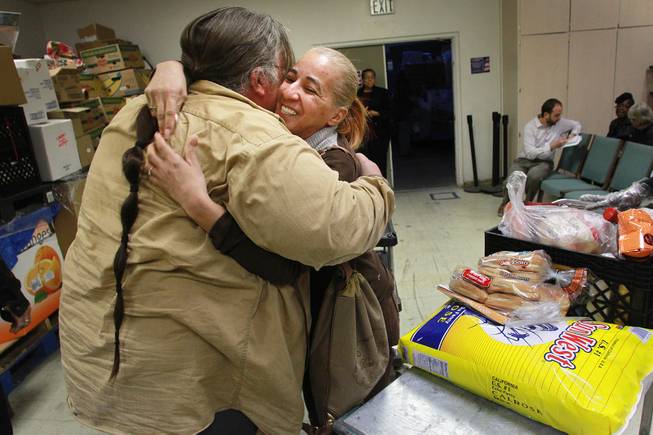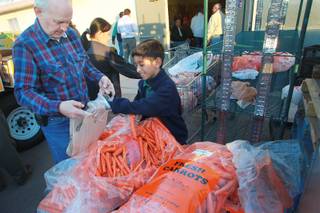
Sam Morris / Las Vegas Sun
Volunteer and program supervisor Shane Smith gets a hug from Zada Walker after she picked up her donated food at Our Savior Church’s food line Wednesday, Feb. 5, 2014 in Henderson.
Friday, Feb. 7, 2014 | 2 a.m.
After three years, the food distribution program at Our Savior Lutheran Church in Henderson runs like a well-engineered factory line.
It’s structured to cut down on wait times, organize the goods it receives daily and manage an influx of people, which has been particularly helpful recently.
It is too early to draw definitive conclusions, but food pantries across the Las Vegas Valley say they are experiencing increased demand since federal food aid was reduced in November. Compounding the problem, long-term unemployment benefits expired in December, and an attempt in the U.S. Senate to renew them for three months failed Thursday.
On Wednesday night, those in need lined up at Our Savior. The volunteer staff of 30 has carefully planned to provide boxes of goods pre-packed according to the size of the household.
From 4 p.m. to 7 p.m., more than 200 families come through the food pantry. Each hands a ticket to a clerk and receives a box with dry goods and some protein; they pick a loaf of bread or two off the shelves and receive whatever fruits and vegetables are available that day at another station on their way out the door. Along the way, almost everyone offers a hug or handshake for staff members.
Shane Smith, who supervises Our Savior’s food pantry, stands behind a row of coolers, grabbing frozen meats for clients as they come down the line.
“We’re seeing more people coming in, people who haven’t come to us before,” he says. “I’ve noticed more middle-class people who were doing OK, but now aren’t making ends meet anymore. They’re frustrated and scared, because this is all new to them.”
In November, almost all of the 47 million Americans who receive Supplemental Nutritional Assistance Program benefits (commonly called food stamps), saw a reduction in their monthly payment.
According to the latest data from the Nevada Department of Health and Human Services, approximately 370,000 people receive SNAP benefits in the state, a 4.4 percent increase over a year ago. After the reduction, which was the result of an expiring federal stimulus program, the average benefit in Nevada went from $121.15 to $115.25. Benefits for a family of four were cut by $36 a month, and the average benefit dropped to less than $1.40 per person per meal.
Despite the word “supplemental” in the title, 20 percent of SNAP households have no cash income whatsoever, according to U.S. Department of Agriculture reports.
“A lot of folks are using SNAP benefits as the only money they have for food,” Jodi Tyson, government affairs director for Three Square Food Bank, said. “When they lose other types of benefits, that hurts their bottom line and pinches them even more.”
Zada Walker started coming to the Our Savior food pantry two months ago, when the SNAP benefits for her and her two daughters were cut $29 per month.
“It is a strain because things were tight before the reduction,” she said. “I’m a vegetarian and so are my girls, and I find it hard to find cheap foods that have the nutrition we need. If I find I have $5 extra at the end of the month, I can’t spend that on something for the girls. I have to limit myself and put that away because everything is so tight.”
Clark County is home to approximately 70 percent of the state’s SNAP recipients. The valley’s pantries get their food from the Three Square Food Bank and partnerships with grocery stores and other private businesses that pass on the food that has gone past its “sell by” date or is otherwise safe for consumption but cannot be stocked in the store any longer.
Since 2006, the number of people receiving food aid from pantries and related services has increased nearly 50 percent, according to Feeding America, a national group of food banks, including Three Square, which serves 100,000 people across Southern Nevada through its 600 partners.
Administrators at Three Square are worried that the reduction in SNAP benefits, and the more recent end to extended unemployment insurance, will put more pressure on their already strained services. Roughly 17,000 Nevadans lost their unemployment benefits at the end of December.
“My budget hasn’t changed in the six years I’ve been running the pantry, and our clientele has quadrupled,” said Conrad “Pastor Tiny” Steinhauer, who runs the food pantry at Grapevine Church near Nellis Boulevard and Sahara Avenue.
“We are getting quite a few people who are new to us or are coming more often because they lost SNAP money or their unemployment benefits,” he said.
In the past year, the Freedom Foursquare Outreach program at Grapevine has gone from serving 140 families per month to 217.
At Our Savior, there is a five-day-a-week program to distribute baked goods, fruits and vegetables, and the weekly Wednesday night distribution of groceries and meat in addition to regular pantry items. In January, 14,000 people were served, the highest monthly total ever.
“The need has increased greatly here over the last few years, and part of that is because this area was hit harder in the recession,” said Mike Martinez, who helps run Our Savior’s pantry. “Now with benefits being cut, people are hurting more. We also see more and more seniors, who really don’t have any hope of increasing their income. Maybe their kids lost their house and they moved back in, and now the whole family is stretched.”
Our Savior, a congregation of fewer than 100, was named Three Square’s first “Agency of the Year” in 2013 for its dogged dedication to fighting hunger in the community under the direction of Pastor Ed Bruning. The church is spread thin, however, as more and more people find their way to its pantry, and they are searching for new resources to meet demand.
Food pantry administrators say they are also seeing more of the “working poor,” families with one or more members who are employed, but they still cannot put enough food on the table or meet monthly bills.
William Lines makes $31,000 per year working for a document destruction company, but recently turned to the Our Savior food pantry to help provide enough food for his pregnant wife and two children. He says he applied for SNAP, but because the pay stub he submitted included an unusual amount of overtime, he was denied and will have to reapply.
“The pantry has helped a lot, especially in getting enough good food for the kids. Meat, fruit, vegetables, it’s all so expensive,” he said. “These are tough times.”
Most of those picking up food at Our Savior on Wednesday said the legislators in Congress demanding even deeper cuts to benefits should try getting by on their budgets.
“I start shaking I get so mad when I hear the news about the debate in Congress,” said Wilma Miles, 70, who saw an $11 cut in her monthly SNAP benefits. “They found a way to keep billions in agricultural subsidies in the farm bill, but cut food stamps. They should get out from behind their walnut desks and spend a month in our shoes.”


Join the Discussion:
Check this out for a full explanation of our conversion to the LiveFyre commenting system and instructions on how to sign up for an account.
Full comments policy